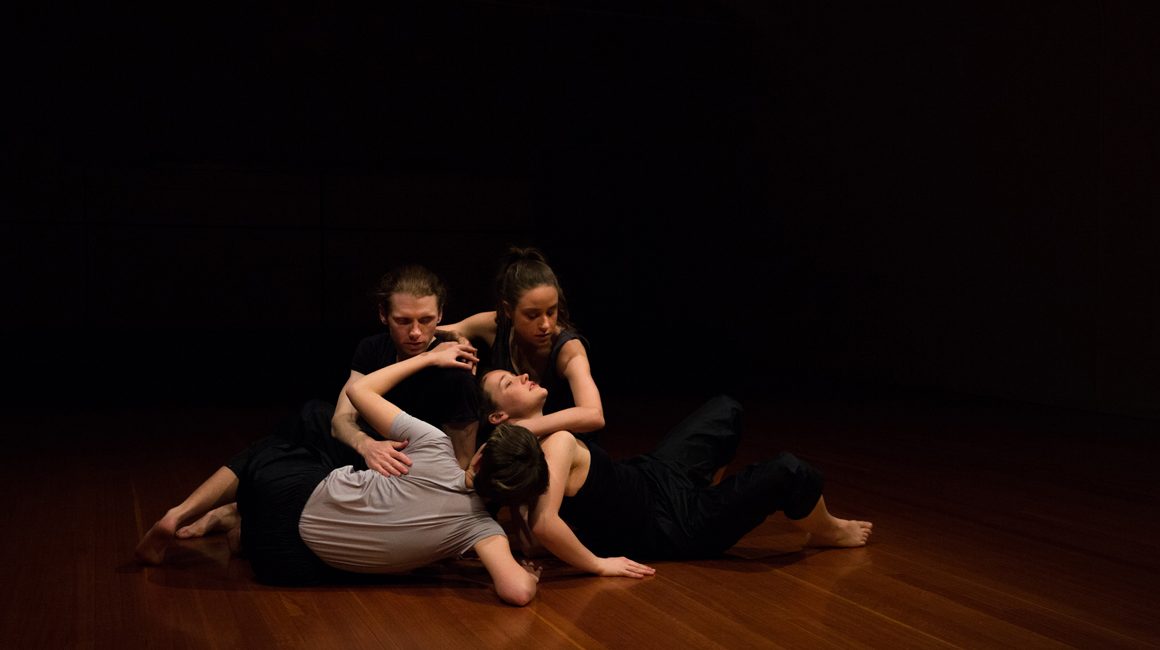‘Meticulously planned and conscientiously put together, it suggests a feeling of completeness and sufficiency’: Andrew Fuhrmann on Siobhan McKenna’s Utterance
What are they whispering? Three women and one man lie sprawled in the centre of the room. Around them, the audience is arranged in traverse. One of the women has her head tilted so that it catches the faint downlight. She has an expression of infinite calm, like the face of an ancient marble bust. Except, mystery of mysteries, the lips are moving.
At first I hear only a thin sibilant murmur. I lean forward. Am I hoping the whispered words will provide some clue to interpretation? Suggest some frame of reference? The lights slowly come up and the whispering becomes louder.
The performers all wear simple dark grey or navy, a shiny, synthetic material that shifts colour, depending on the angle of sight. The fabric hisses softly as they move, as if in imitation of the hushed voices. Slowly the performers rise and, leisurely, with a kind of sensuous fluidity, unfold themselves as a group across the space.
Now the words can be recognised, if not necessarily understood. Pacing the spatial space practicing mindfulness. Pacing the spatial space practicing mindfulness. Chanted over and over. There are pauses, sudden suspensions of sound and movement. The rhythm varies. As one they stop chanting and then as one begin again. The patterns become more complex; but the timing of the four performers is faultless. There’s something spooky, almost machine-like, about this verbal synchrony and its strong relationship to the movement. It’s as if the utterance is utterly the dance.
The spookiness is also linked to the partial suppression of difference between the four performers, Arabella Frahn-Starkie, Emma Riches, Hillary Goldsmith, Rhys Ryan. They’re costumed similarly, speak in similar monotones, and have the same deadpan expressions. They move slowly and carefully, attentive to each other’s progress. With arms held out loosely, artistically curved, they fill the spaces between each another without touching. The effect is something like the gently twisting tendrils of an art nouveau doodle.
Eventually the quartet coalesces, writhing together in a knotty floorwork sequence, ravelling the dance up to a stopping point. After a pause the tangled mass begins to loosen, pushing back and forward, the bodies separating and rising to their feet again. Now they’re holding hands and swaying, still chanting.
Utterance is such a satisfying, well-made dance. Meticulously planned and conscientiously put together, it suggests a feeling of completeness and sufficiency. Choreographer Siobhan McKenna, who graduated from the VCA in 2016, creates movement that is fluid and sustained and always economical, recalling the work of Trisha Brown and her followers. The ability of the performers to reproduce the sequencing so fluently is also deeply impressive, although I did find myself occasionally wishing for a bit more finish and precision.
The work, which won the Best Dance award at the 2017 Melbourne Fringe Festival , has been revised and extended since its premiere a year and a half ago. There’s now a sequence involving deep bends and a complicated sort of lift and flip with no arms. Although this material doesn’t significantly lessen the achievement of the work, I don’t think it really adds much. And in any case, the shorter run time felt more appropriate to such a structurally neat and conceptually focused work.
But what about that mantra? Pacing the spatial space practicing mindfulness. What does it mean? Well, whatever it might have meant originally, after a few minutes of repetition it means nothing. McKenna here is playing with the concept of semantic saturation, the phenomenon whereby relentless repetition of a word or phrase renders it meaningless. McKenna, then, uses this technique to create a weird, babbling soundscape that the dancers produce as they perform, as if their bodies were entirely this strange chantic music.
It’s said that semantic saturation proves the conventionalist view of linguistic meaning, because it shows that there is no intrinsic or natural connection between the sound of a word and its significance. Words like “space” or “mindfulness” might signify anything; it’s merely social convention that links them to familiar meanings. What is interesting here, in the context of this performance, is that the pioneers of the downtown New York tradition in which Siobhan McKenna is working had similar ideas about movement. McKenna is not working with de-familiarised gesture in this piece – or not much – but the idea that movement can be a neutral activity, without any natural or intrinsic meaning, is fundamental to this sort of choreography.
But Utterance is not a dry or merely academic work; it’s strange and clever and funny. After a while, the mantra subsides completely. The dancers then begin to moan: long, low forceful exhalations. These gradually transform into dead pan wooows. It’s the sound you might mutter at a party while listening to a story that goes on and on. And, indeed, as the dancers slowly tumble across one another, Rhys Ryan does tell begin to tell a story about a Halloween party. The three women respond regularly and mechanically. Wow. Wow. Wow. (Think, for example, of Ann Magnuson, while we’re talking about downtown New York). A circle forms centre stage and all four, sitting with their legs to one side, begin to whip their heads back and around as their deadpan exclamations of delight increase in volume, building to a climax.
This is an encouraging work because it combines rigour and conceptual seriousness with a sense of humour and an eye for theatrical detail. It will be fascinating to see where this exciting emerging choreographer goes next.
Utterance, choreographed by Siobhan McKenna and performed by Arabella Frahn-Starkie, Hillary Goldsmith, Emma Riches and Rhys Ryan. Costumes designed by Helene Frøsiland, lighting designed by Nick Glen. Sound advisor, Lena Douglas. Dancehouse, 150 Princes St, North Carlton. Closed.
This event is not wheelchair accessible.

